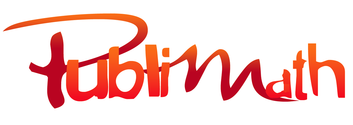Proceedings of the Eighth European Summer University on History and Epistemology in Mathematics Education. Sources from the 16th century for the teaching and learning of mathematics. p. 626-639.
(Des textes-sources du XVIe siècle pour l'enseignement des mathématiques.)
Une version texte intégral est en téléchargement sur le site Bibliothèque numérique des IREM et de l'APMEP Télécharger
Auteurs : Romero Vallhonesta Fàtima ; Massa-Esteve M Rosa
Résumé
Cet article présente des activités en classe, expérimentées en Catalogne, au niveau collège et en formation des enseignants, autour de deux problèmes tirés de quatre traités mathématiques des XVe et XVIe siècles. Pour le premier sont offertes trois formulations similaires tirées de l'Arithmetica (1484) de Pietro Borghi, du Coss (1525) de Christoff Rudolff et du Libro Primero (1552) de Marco Aurel, concernant l'embauche d'un travailleur. Le second présente une situation posée par un élève à un autre dans le dernier livre de l'Arithmetica Practica y Speculative (1562) de Juan Pérez de Moya. L'objectif des auteurs est d'analyser certains aspects du développement de la pensée algébrique à travers l'activité de résolution de problèmes mise en œuvre en classe. Ils concluent que l'analyse des différentes procédures mathématiques pour résoudre ces situations tirées de l'histoire peut inciter les élèves à concevoir leurs propres méthodes face à une situation problématique inconnue. Abstract The use of original texts from History of Mathematics is a way to introduce the sources on which mathematical knowledge is based into the classroom. Choosing historical texts carefully can help students to develop their mathematical reasoning skills and to realize the humanistic aspects of mathematical knowledge through the understanding of the formation process of mathematical thinking. In this paper we present two problems drawn from four mathematical treatises from the 15th and 16th centuries. For the first one, we present three similar wordings drawn from the Arithmetica (1484) by Pietro Borghi, the Coss (1525) by Christoff Rudolff, and the Libro Primero (1552) by Marco Aurel, which concern the hiring of a worker. The second one is a situation that was posed by one student to another in the last book of the Arithmetica practica y speculative (1562) by Juan Pérez de Moya. Our aim is to analyse some aspects of the development of algebraic thinking through the mathematical activity of problem solving, implemented in the classroom. The analysis of the different mathematical procedures for solving these historical situations can encourage students to devise their own methods when faced with an unknown problematic situation.
Notes
Chapitre des Actes de la huitième université d'été (ESU 8) .
Données de publication
Éditeur Oslo Metropolitan University Oslo , Norvège , 2019 Format p. 626-639 Index Bibliogr. p. 638-639
ISBN 82-8364-211-1 EAN 9788283642117 ISSN 2535-6984
Public visé chercheur, enseignant, formateur
Type chapitre d’un ouvrage Langue anglais Support papier
Classification
